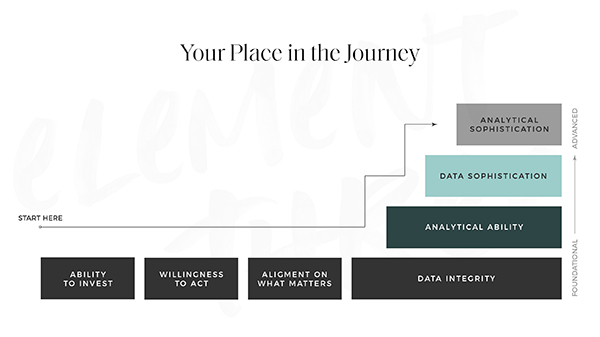Reaching marketing maturity allows your team to utilize actionable scorecards to guide decision making.
Many marketing teams lack the infrastructure to clearly show a relationship between marketing’s activities and their business objectives. To close this gap, there are three areas to address: the creation of marketing-accountable metrics, usage and collection of data, and communicating the actions to take off the data. Improve in these areas and you’ll be able to create a mature marketing organization.
It’s very common to find marketing metrics that are vanity indicators. This challenge is prevalent because there are no standard metrics which always need to be measured. It’s low hanging fruit to pick on website traffic and social media impressions as purely vanity metrics — but less obvious vanity metrics also exist. Marketing qualified leads, sales qualified leads, and even marketing generated revenue can be vanity metrics if they’re measured incorrectly. Ideally, a marketer would use an attribution model and show a relationship between marketing’s activities and revenue. These perfect cause-effect relationships often don’t exist. An example to illustrate this point:
Imagine your business is extremely low volume, with a premium price. Prospects are going to be speaking to a wide variety of influencers before making a purchase. If they find out about your business through a paid ad, then speak to sales, are sent follow up marketing collateral, work with your team to design the right solution before signing — who gets credit for that win?
This illustrates the difficulty in attribution modeling. Marketing teams are creating a scorecard which, at its best, showcases part of the picture. The fix is to align your marketing metrics with specific business objectives — allowing you to measure without obsessing over the attribution.
Moving from messy attribution modeling to an actionable scorecard is dictated by the level of maturity of your marketing program. This model provides a framework for how to envision the path:

Your place on this journey will dictate the time you spend working to a place of confidence in marketing’s accountability. If your organization has not invested in marketing in the past, your path to an actionable scorecard will look different than if you’ve already worked to have solid data integrity.
Understanding the impact of marketing’s efforts on organizational performance comes from building enough data to test different hypotheses against each other. The marketing program will need to set a hypothesis, set up a test to evaluate the outcome, and adjust over time. The time it takes to learn from that data is largely dependent on your willingness and ability to invest. A company that has access to the appropriate talent to build and test campaigns and can also invest $100,000+ in paid media per month will learn significantly faster than a company who can only invest $10,000 per month in paid media. There is simply more data, and therefore more to learn.
Investment is a prerequisite for marketing maturity and an actionable scorecard. Your team needs to be aligned on what gets measured, and you will need the right technology for high-integrity data which can be analyzed to create your scorecard. Your metrics will be vanity unless you can clearly articulate the relationship between the metric and the business goal.
Our Senior Director of Strategy at Element Three, Dustin Clark, is constantly using the framework of Care-Do-Impact when we discuss measurement for our clients. Numbers are just numbers until they have context.
As a leader, why should I care about this metric? As an organization, what will we do to move it in the right direction? As a contributor, what is my responsibility in implementation? How will the leader be able to know if those actions had the intended impact?
Reporting through this lens allows you to make your scorecard more actionable, regardless of where you’re at on the path to marketing maturity. If you’re very early on in building your scorecard — working to understand how marketing takes accountability for business objectives — you will find it difficult to present your metrics in a Care-Do-Impact way. When you reach that point, you’re achieving a new level of maturity and you’ve found an actionable scorecard.
When you reach a point where your metrics level up to a business goal, your data is being collected accurately, and you’re able to communicate in a Care-Do-Impact model, you have reached an important level of marketing maturity. This will take time. It will take investment, and a willingness to admit when you’re wrong. Marketing operates most effectively when your mindset is less politician gathering buy-in, and more scientist discovering truth. Work to achieve the three areas highlighted above and you’ll be working in the scientist bucket.
Joe Mills is the Business Development Manager at Element Three, a full-service marketing consultancy based in Indianapolis that works with some of the nation’s top manufacturing brands
In this episode, I sat down with Beejan Giga, Director | Partner and Caleb Emerson, Senior Results Manager at Carpedia International. We discussed the insights behind their recent Industry Today article, “Thinking Three Moves Ahead” and together we explored how manufacturers can plan more strategically, align with their suppliers, and build the operational discipline needed to support intentional, sustainable growth. It was a conversation packed with practical perspectives on navigating a fast-changing industry landscape.